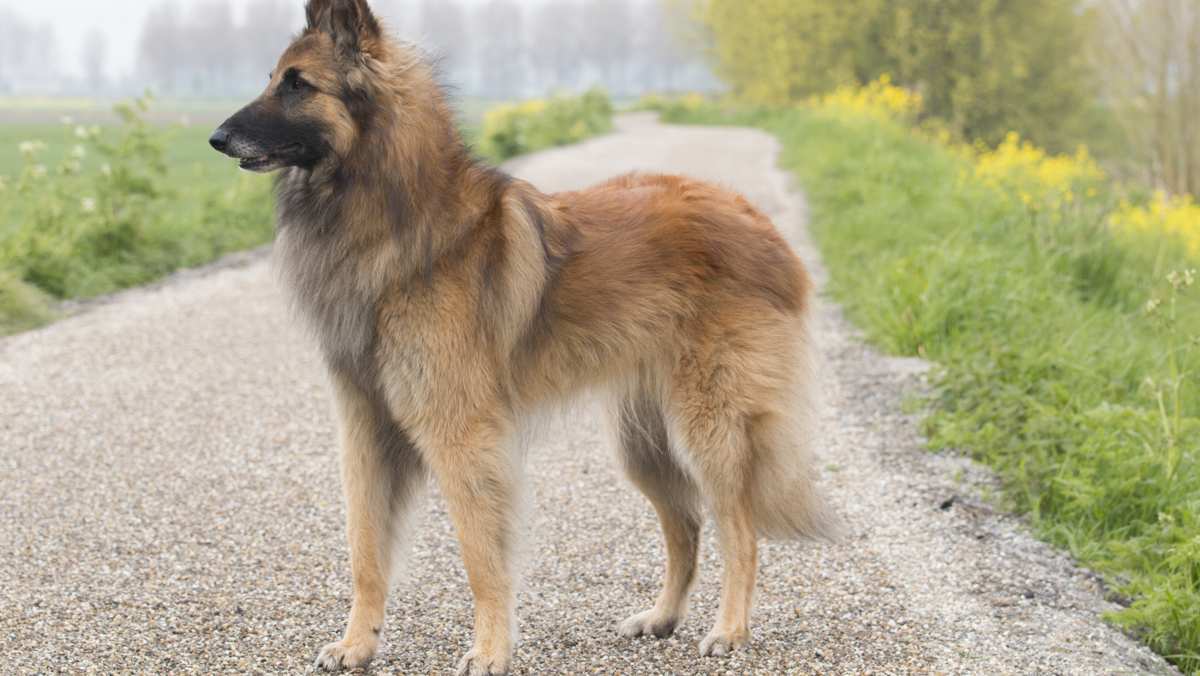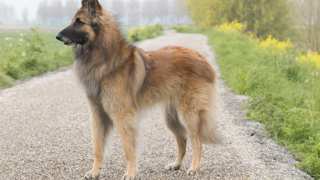Belgian Tervuren Dog Breed
Belgian Shepherd Dog
Belgian Shepherd Tervuren
Chien De Berger Belge
Tervuren
[Pronunciation: Bell-juhn Tuhr-VIEW-rin]
The Belgian Tervuren is a medium-sized, medium- to long-haired shepherd breed that originated in Belgium. "Tervs," as they're known for short, are hard-working, playful, and sensitive in temperament. They require moderate care (little grooming, some training, and lots of exercise), and are considered very healthy.
Dogs of this breed are best suited to active, experienced owners who can provide their dogs with plenty of physical and mental stimulation, and a great deal of attention. Tervs are not recommended for first-time owners.
Belgian Tervuren Breed Details
The Belgian Tervuren, a member of the Herding Group of breeds, is one of several types of Belgian Herding Dog breeds that have existed for centuries. "Tervs," as they're commonly known, are extremely versatile: they're intelligent and athletic, they have a good work ethic and train easily, but they also need a lot of attention from their human families. Overall, dogs of this breed are best suited for experienced owners who can provide their Tervs a lot: exercise, mental stimulation, and plenty of meaningful companionship.
A few Tervuren facts: they're medium-sized (height at the shoulders averages 24 inches, and weight 60 pounds), with medium- to long-haired, thick, double-layered coats in various shades of brown and black. Here are some good (and not so good) qualities of this versatile breed:
PROS:
- Highly intelligent
- Athletic and agile
- Adaptable to both hot and cold weather
- Easily trained
- Affectionate and playful
- Excellent watchdog abilities
- Competes very well in obedience and agility trials
- Fairly easily groomed
CONS:
- Suffers separation anxiety (barking/destructiveness) if left alone
- Sheds quite a bit
- High exercise requirements
- Strong herding instincts mean they will chase most moving objects (people, other pets, even cars)
- High tendency to wander; will need constant supervision when outdoors
- Usually shy and reserved around strangers
- Frequent attention from human family members required
Purebred
10 - 12 yrs.
22 - 26 in.
55 - 75 lbs
OverallFamily FriendlyChild FriendlyPet FriendlyStranger Friendly
Easy to GroomEnergy LevelExercise NeedsHealthShedding Amount
Barks / HowlsEasy to TrainGuard DogPlayfulnessWatch Dog
Apartment DogCan be AloneGood for Busy OwnersGood for New OwnersIntelligence
Belgian Tervuren Breed Description
Belgian Tervuren dogs 101 is that they're quite complex animals. Tervs have spent years as herding and police dogs, so they're physically and intellectually gifted--but while they can be confident and independent when given a task to perform, they're also extremely sensitive and needy, and will usually become highly upset if not shown a good bit of TLC.
Decades spent in the fields supervising livestock has developed an incredible herding instinct in these dogs. When out for a walk or jog, a Terv will likely be constantly tugging at its leash, ready to chase joggers, bicyclists, even 18-wheelers, not to mention every other animal they encounter. And when inside they'll spend their time chasing both the cat and the kids in an effort to move them to where the Terv thinks they need to be. But leave a Terv alone? If left outdoors (even in a fenced yard), owners are likely to find the dog gone when they return. And cooped up alone in a house, a Terv will first bark nonstop for hours, then proceed to tear everything to shreds. Without a doubt, these dogs are happiest when they receive constant attention from their human families.
One way of providing that attention might be having a Terv compete in canine trials. They're athletic, strong, and dexterous, and will be at their best when provided a lot of physical (and mental!) activity.
Belgian Tervuren Breed History
Belgian Tervuren history begins, unsurprisingly, in Belgium. Prior to the late 1800s, the Tervuren was simply considered one variety of several types of Belgian Shepherd Dog, which had already existed as an all-purpose herding dog for centuries. But in 1891, Belgian breeders formed the Club du Chien de Berger Belge (Belgian Shepherd Dog Club), and the organization soon divided the different breed types by coat length and color: the Groenendael (long-haired black coat), the Tervuren (long-haired, any color other than black), the Malinois (short coat), and the Laekenois (wire-haired coat).
The Tervuren type is named after the village of the same name, where lived a breeder named M.F. Corbeel. Sometime in the mid-1890s Corbeel bred two fawn-colored Belgian Shepherd Dogs named Tom and Poes; their offspring, simply named Miss, was then bred with a black Belgian Shepherd. One dog in Miss's litter was a fawn-colored dog with black overlays on its coat named Milsart, which went on to win first prize at the national dog show in Belgium in 1898; Milsart is now considered the model for all Belgian Tervuren dogs which came after it.
As years passed, the Tervuren variety became popular throughout Europe, and eventually dogs of this type began being imported to North America. In 1918 the American Kennel Club registered its first Tervuren, but due to low interest in the breed the Tervuren disappeared from the AKC's stud book by about 1940. Post-World War II, enthusiasts began showing interest again, and in 1959 the AKC recognized the Belgian Tervuren as a distinct breed. Today, Tervs rank 107th out of 190 AKC-recognized breeds.
Belgian Tervuren Temperament
Intelligent, sensitive, hard-working, playful, and needy, the typical Belgian Tervuren temperament is one of versatility and bonding. Dogs of this breed work hard and play hard, and they form deep attachments with their owners that can make them emotionally fragile. Tervs need a lot of attention, and will become visibly upset if ignored. They normally get along pretty well with children and other pets, but their strong herding instincts will make them instinctively chase kids and animals--along with almost everything else that moves. These dogs need plenty of early socialization and training to teach them not to "herd" moving objects.
Any training a Terv does receive, though, it will respond very well to. They're intelligent and intuitive, and normally learn tasks and commands with few repetitions. Since Tervs are both sensitive and playful, training sessions should be positive, reward-based, "play"-oriented, and consistent.
Though Tervs can be meek around strangers, their loyalty and athleticism make them great watchdogs. They will typically investigate (and sound a vocal alarm) if confronted with a potential threat.
Belgian Tervurens are quite healthy and hardy overall. Dogs of this breed can suffer a few inherited conditions including hip or elbow dysplasia, Progressive Retinal Atrophy, and epilepsy. Life expectancy is 10-12 years.
Belgian Tervuren Health Concerns
Below are potential health concerns associated with Belgian Tervurens.
Hip dysplasia
Progressive retinal atrophy
Epilepsy
Elbow dysplasia

